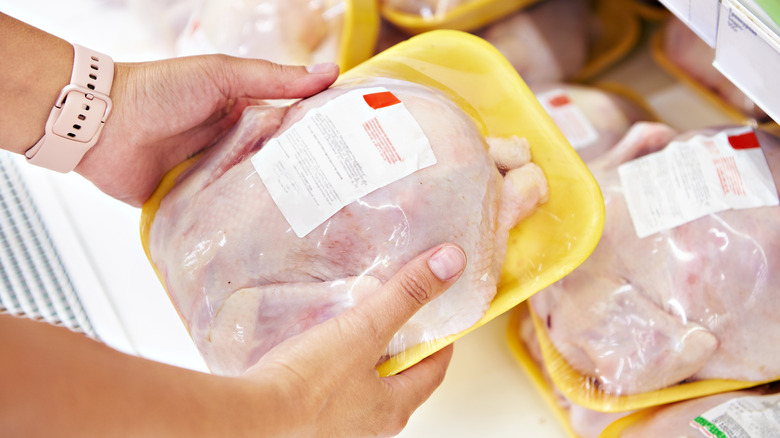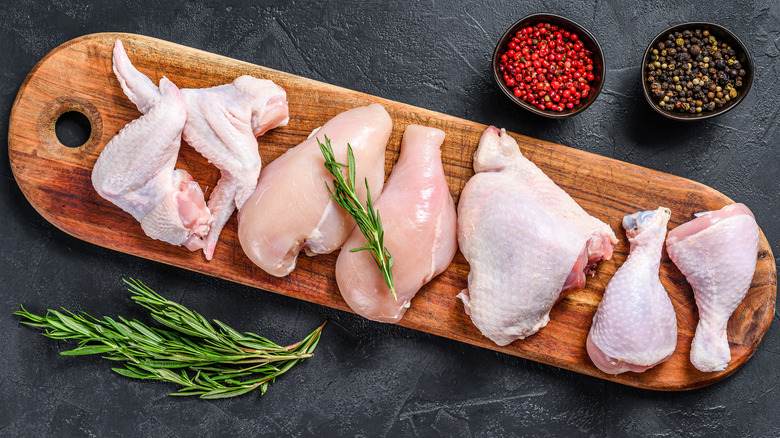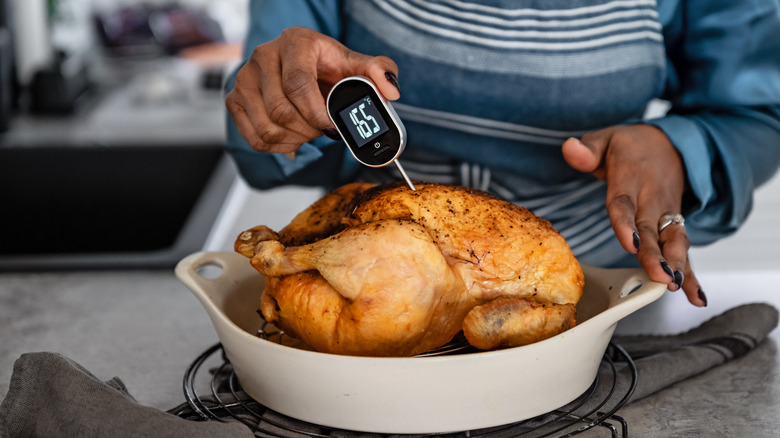The Safest Place To Store Raw Chicken In The Fridge
Proper storage is essential with raw meats and chicken because they carry a risk of salmonella and other food-borne illnesses, and one of the easiest ways these bacteria can reach your stomach is through cross-contamination. This is the process by which dangerous microorganisms move from one ingredient (in this case raw poultry) to other foods or kitchen items. While this can occur when you cook a meal, it can also happen as your food sits in the fridge. Fortunately, all it takes is a good strategy to organize your refrigerator and you can mitigate this from happening.
Chicken should always be kept at the lowest possible part of your refrigerator. If you store raw poultry on a higher shelf, there is a possibility that the juices will escape the packaging and drop onto other parts of your fridge, and you'll have cross-contamination on your hands.
This is a serious issue if the juices contaminate something meant to be eaten raw, like salad greens or other produce. If these items are not cooked, the bacteria cannot be eliminated through heat. Even if the juices are not falling onto other items, you still don't want them touching the shelves. To further prevent this, you can place chicken (while still in its store-bought packaging) on a rimmed plate or tightly cover it with plastic wrap.
Temperature and timing matter for safe chicken storage
Beyond limiting cross-contamination, the bottom shelf is ideal for storing raw chicken because it is the coldest area of many refrigerator models. This occurs due to thermodynamics; warm air naturally rises to the top of the fridge, while cold air sinks to the bottom. Bacteria grow most readily in what the USDA calls the danger zone, which is 40-140 degrees Fahrenheit. For this reason, a refrigerator should never go above 40 degrees Fahrenheit. The ideal fridge temperature is generally 35-38 degrees Fahrenheit, as anything lower will run the risk of freezing.
Timing is equally important when making sure your chicken stays fresh and safe. After purchasing, refrigerate your poultry within two hours, and cook it within two days. If you can't use it in time, freeze any raw meat you have. For the best results, place the chicken inside a freezer-safe bag and push out as much oxygen as possible before sealing it. Air causes items to develop freezer burn, so limiting any exposure will help the chicken maintain its quality. While the product will stay safe indefinitely in the freezer, use it within nine to 12 months for the best results.
Keeping your chicken safe from contaminants while cooking
Now that you've stored everything properly, let's say you're setting out to cook a juicy chicken breast. While you're cooking, there are a few guidelines to keep food-borne illness at bay in this scenario, too. For one, you should never wash meat before using it. Doing this can spread raw juices to your sink, which can easily cross-contaminate other items you wash afterward. Beyond this, washing the bird will not actually rid it of harmful bacteria. Only cooking it will do so.
If you're cutting the chicken, remember to thoroughly wash and sanitize the cutting board, knife, and anything else that came into contact with the poultry. Similarly, wash your hands for at least 20 seconds. Once you have a pan on the stove, you need to cook the bird to at least 165 degrees Fahrenheit to eliminate any bacteria. Make sure you have a food thermometer on hand; not only will this tell you when your chicken is safe to eat, it's also a helpful way to check the temperature to prevent the meat from overcooking.



